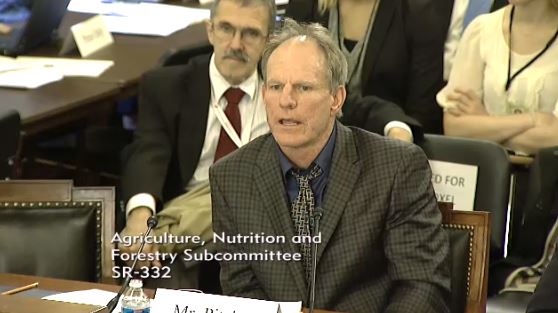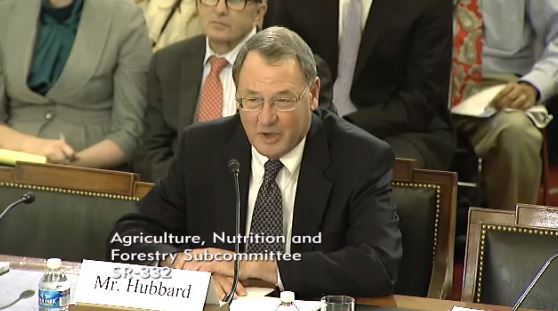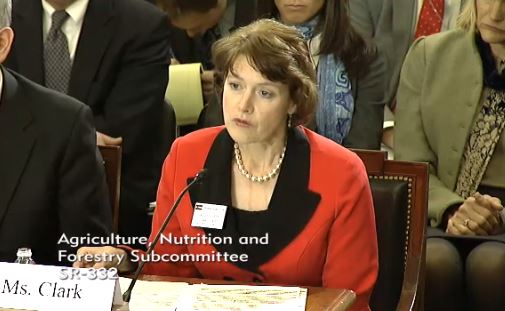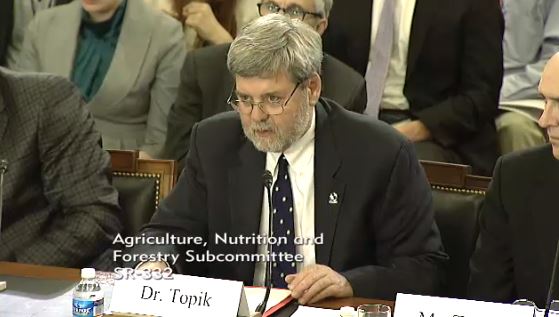 On November 5 the Senate Subcommittee on Conservation, Forestry and Natural Resources held a hearing titled, “Shortchanging Our Forests: How Tight Budgets and Management Decisions Can Increase the Risk of Wildfire”. A video recording of the hearing can be viewed at the subcommittee’s website.
On November 5 the Senate Subcommittee on Conservation, Forestry and Natural Resources held a hearing titled, “Shortchanging Our Forests: How Tight Budgets and Management Decisions Can Increase the Risk of Wildfire”. A video recording of the hearing can be viewed at the subcommittee’s website.

It was held in a small room where the five witnesses outnumbered the four Senators. Generally, the attendees recommended that the government must invest more in forest thinning, prescribed fire, and hazard reduction projects.
Below are some excerpts from the written testimony of a few witnesses. Their statements can be downloaded at the website.
From Jim Hubbard, USFS Deputy Chief, State and Private Forestry:
When a wildfire starts within or burns into a fuel treatment area, an assessment is conducted to evaluate the resulting impacts on fire behavior and fire suppression actions. Of over 1,400 assessments conducted to date, over 90 percent of the fuel treatments were effective in changing fire behavior and/or helping with control of the wildfire (USFS, Fuels Treatment Effectiveness Database).

From Sallie Clark, El Paso County Commissioner, Colorado:
A 2007 Congressional Budget Office study indicates that every dollar invested in healthy forest and wildfire mitigation will save more than five dollars in future disaster losses.

From Christopher Topik, Director, Restoring America’s Forests, The Nature Conservancy:
Our current approach to wildland fire and forest management creates a false choice, pitting the viability of one against the other. In reality, we cannot afford to short-change either. The potential costs are too great.
SUMMARY OF KEY RECOMMENDATIONS
I. Budgetary
1. Increase federal funding for hazardous fuels reduction, Collaborative Forest Landscape Restoration and associated proactive federal land management operations and science
2. Create and fund a new federal fire suppression funding mechanism to free up resources for proactive management referenced above
3. Permanently authorize stewardship contracting authority
4. Increase capacity of states and communities to become fire adapted
5. Increase research on economic, social and ecological impacts of forest investment
II. Management Decisions
6. Seek policy adjustments that foster innovation and improvement in NEPA implementation, thereby increasing the scale and quality of resulting projects and plans
7. Increase shared commitment and support for forest restoration by states and local governments
8. Enhance participation of additional sectors of society, such as water and power utilities, recreation and tourism, public health, and industrial users of clean water
9. Increase the safe and effective use of wildland fire


WFF
Don’t if it is a”stellar” response…..but surely every year or two, like any other Guv Agency, coming to ask for more dinero…..
I come from a forestry and Wildland fire background and now all risk all hazard background…….
If there are more stellar answers or better ones out there…..let’s see ’em!,,,
A lot of this is repetition from other years and more of the same.
How about that increased capacity for States to become fire adapted…..where do you suppose some of that money comes from? Yep the taxpayer through S&PF grants an direct payment, FIREWISE money through Fed grant app
You know, saying the same thing year after year…….like a pre scripted template.
Yeah, that kind of “work and effort” from F & AM staff is only the same every year
Yeah, those same responses and “effort” are stellar responses also…….and pretty obvious to us foresters who have gone on to other fields that directly support Wildland fire operations, who saw the light, that PFT jobs and careers were not on the radar early on due many obvious factors, but we were able to see outside looking in……….we knew these things years ago that WO FAM has the same requests from the taxpayer, about thinning, fuels reduction, and other projects that the famous NEPA processes have held up for years.
Yeah, stellar operations requiring stellar funding and actual applications to the 9 key recommendations mentioned here that are really not new to the field of forestry……..or are they all of a sudden?
WOW those are two stellar respones, awesome.
Has anyone thought about actually preventing the ignition in the first place?
Tight budgets for the land management agencies? Say it isn’t so!
After reading Time magazine 4 Nov 2013, pages 14 through 18……the parallels of the Army bureaucracy and the USFS bureaucracy are very well steeped in tradition.
Also after reading Aviation Week and Space Technology, Oct 14/2013, page 80, on the possible future reliance of Guard and Reserve assets by Active Duty missions…..
Proves once again that with the lean budgets are hitting everyone somewhat equally. But there will be the folks who say we are short changing programs.
Guess what? The lean years…….the military is getting a hefty cut and the LMA’s need to see a deeper cut or increase the pot of money to the States as the military is seeing in the National Guard and Reserves.
Better stop dreaming of UAV’s and UAS systems, combined Lead and ATGS ships and start CONCENTRATING on the mission of land management…..with all the rules in place……..the Congress and LMA’s have strangled numerous programs.
How many ways and years does it take to reduce fuels and ask for money for land management
Oh wait it’s 2013 …….it’s like aviation…….every thing costs more but nobody was brilliant to project 20,30,40′ and 50 years ahead …even with alllllllll those fancy computer programs
Should have been bankin away money years ago, folks!!!!
Real life is upon us and you…….live within your means!!!!